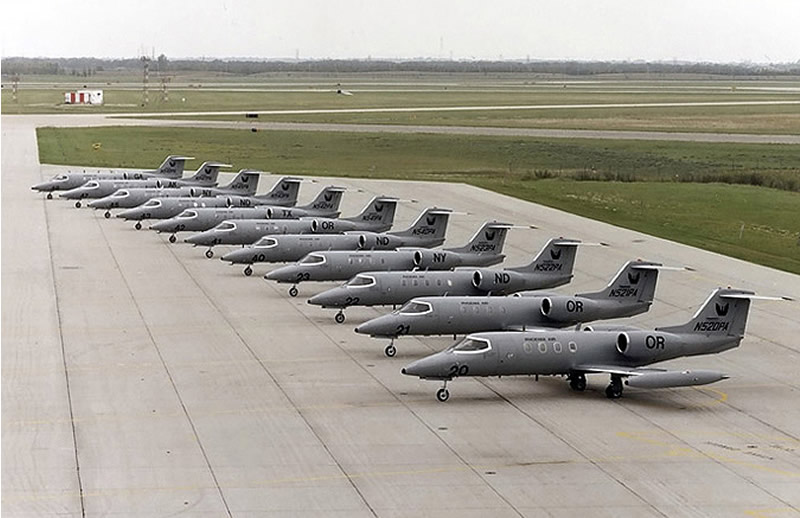Waaaay off topic...But what was the story here? Nice looking Line-up!

If you go back in time to the early 80s the Air Force used to have a squadron of T-33's that were used as 'Ducks', i.e. targets for radar intercept training for both GCI controllers and interceptor pilots. I think some of these T-33's carried simple noise jamming pods
Back in the 80s the T-33s were going away and someone got a law passed that allowed the military to lease civil airplanes from the private sector to perform this function. This is about the same time the air defense function was passing from the active USAF to the Air Guard.
The Air Guard was lead on this program, the first contract went to a company called Flight International in Newport News Virgina. They did a pretty good job with this. Some of their Lears were L35's with an internal noise jammer, some were pure 'ducks', these were mostly L24's. This airplanes were based at National Guard bases and had whatever paint job they had when FI bought them.
About 1991 I was assigned to the Air Combat Command staff at Langley AFB Virginia, in the electronic warfare shop. I was the EF-111A current operations staff weenie. I was an electronic warfare officer, not a military pilot.
One day our Colonel came in the office and we had this conversation:
Colonel: "Jim don't you fly those bug smashers at the aero club?".
Jim: "Yes sir, I do".
Colonel: "There's this little contract that the Guard runs that rents bug smashers for some kind of beeps and squeaks stuff. Old Joe used to handle it but his replacement isn't here yet. Here's this message where the Guard wants to renew the contract and I guess we're involved. Please look into this".
Jim: "Yes sir!"
I called the Guard action officer and found out that the 'bug smashers' were Lear Jets!! And indeed the contract was coming up for renewal in about 18 months and we needed to start working on an RFP for it.
Of course since I clearly needed to get familiar with the program, and since FI's base was only a short drive away it was clear to me that the incumbent contractor needed my 'supervision', so I bagged a bunch of rides with them.
To keep this on topic at least a tad, this is where I encountered 'public use' aircraft.
About this time the Post Office published an RFP to lease B727s to carry the mail. It turned out their RFP was not well written and IIRC the award was canceled and the Post Office had redo the whole thing, after a bunch of lawsuits. We really wanted to learn from their mistakes.
It turned out that the government experts in public use airplanes are what is now called the National Interagency Fire Center (NIFC) in Boise, Idaho. These guys were the most awesome civil servants I've ever met.
They were lean forward get the mission done guys, and were super generous with their time and expertise in helping us not screw up our RFP.
I got to visit several of the bidder sites, they were all capable companies, and I really admired the managers and founders that I met in the process. It takes a lot of guts and a certain amount of craziness to start an aviation company!
We did write an RFP after some delays and awarded the follow on contract to a company called "Phoenix Air" in Cartersville Georgia. The CEO was a very colorful character called Mark Thompson.
The jammer that we equipped these airplanes with used something called '
digital radio frequency memory (DRFM)'. At this time almost all jammers were analog, but we justified buying DRFM because, being digital, it could be programmed to replicate many different threat jammers. And since it was all digital it was kind of to jamming as MIDI is to music. You could program it to make almost any kind of 'music' you wanted, just with a scripting language.
One issue we'd had with the initial contract was that the contractor was allowed to use the Lears for charters when we were not using them. This created some awkward situations for a number of reasons.
Also, since we paid by the hour based on paper forms we kind of, sort of, wondered if there might occasionally be some '
P-51' time in the logs. Not that we could ever prove that, we just wondered.
And we had some complaints that some of the pilots (mostly retired fighter pilots) were doing a bit more low level flying than what was strictly necessary for the mission. Especially in Alaska!
So the new contract said that the planes had to be painted like military airplanes, and were not to be used for other purposes.
We also required that the planes have GPS units connected to an ACARS unit that would automatically report their location and also (via an oil pressure switch) the start and stop motor times. Mr Thompson thought that GPS was a kind of gimcrack and grumbled about installing it, this was well before there were IFR gps boxes. Still, we were glad we knew when and where our airplanes were flying.
We were really proud to brief the four button about the contract, especially about the jammers.
Of course we spent most of the briefing talking about the proposed paint jobs. Sigh.
In any case, I'm real proud of this program, AFAIK it's still in operation, bringing great training and testing to the USAF for a fraction of the cost of using military assets.



